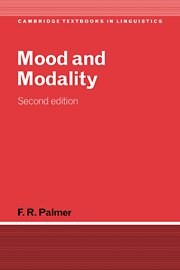Book contents
- Frontmatter
- Contents
- Preface
- Note on the text
- List of abbreviations
- 1 Introduction
- 2 Modal systems: Propositional modality
- 3 Modal systems: Event modality
- 4 Modal systems and modal verbs
- 5 Indicative and subjunctive
- 6 Realis and Irrealis
- 7 Subjunctive and irrealis
- 8 Past tense as modal
- References
- Language index
- General index
5 - Indicative and subjunctive
Published online by Cambridge University Press: 05 June 2012
- Frontmatter
- Contents
- Preface
- Note on the text
- List of abbreviations
- 1 Introduction
- 2 Modal systems: Propositional modality
- 3 Modal systems: Event modality
- 4 Modal systems and modal verbs
- 5 Indicative and subjunctive
- 6 Realis and Irrealis
- 7 Subjunctive and irrealis
- 8 Past tense as modal
- References
- Language index
- General index
Summary
It was noted in 1.2.1 that many languages have the grammatical category of mood, and that in European languages particularly, but not exclusively, this is dealt with in terms of the distinction between the indicative and the subjunctive. An example from Spanish is (Klein 1975: 356):
Insisto que aprende
I.insist that learn+3sg+pres+ind
‘I insist that he is learning’
Insisto que aprenda
I.insist that learn+3sg+pres+subj
‘I insist that he learn’
It was also noted that other languages, particularly the languages of the Americas and of Papua New Guinea, have markers that are labelled ‘realis’ and ‘irrealis’.
It was suggested that basically there is no typological difference between indicative/subjunctive and realis/irrealis, and that both are instances of mood (Realis/Irrealis). There are, however, considerable differences between the functions of what have been labelled ‘subjunctive’ and ‘irrealis’, and, therefore, for practical reasons they will be dealt with in separate chapters (5 and 6). A further chapter (7) will discuss the similarities and differences between them.
Most of the examples in this chapter will be taken from the classical languages, Latin and Greek and the Romance languages, especially Spanish, since there is a large body of literature concerning the subjunctive in that language. Some mention is made of German, which has considerable uses of the subjunctive in its literary form, although in other Germanic languages, e.g. Danish, the use of the subjunctive is almost dead.
Information
- Type
- Chapter
- Information
- Mood and Modality , pp. 107 - 144Publisher: Cambridge University PressPrint publication year: 2001
